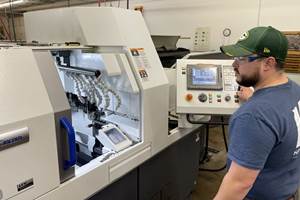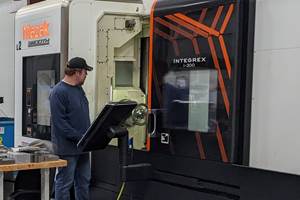Simplifying Documentation Methods
While most companies take setup documentation quite seriously, many do little in the way of program running documentation. This is documentation aimed at CNC operators to ensure they understand just how a cycle is to be run.
Share






While most companies take setup documentation quite seriously, many do little in the way of program running documentation. This is documentation aimed at CNC operators to ensure they understand just how a cycle is to be run. Remember that in most companies the CNC operator has much less experience than the setup person, meaning they need this kind of documentation just as much (or more so) as a setup person needs setup documentation. Truly, ignoring program running documentation can lead to many avoidable problems.
First of all, consider the number of cycles the CNC operator must execute during a production run. For longer production runs, and especially for repeat jobs, taking the guesswork out of the production run can have a big impact on productivity.
Second, if your company runs more than one shift, consider the communication (or lack of it) among operators running the same machine on different shifts. It is likely that if the setup is made on one shift, the setup person will show the operator on that shift how to run the cycle. However, the operator on the next shift may not be shown. Program running documentation can ensure that all operators have access to the same information.
Third, and most important, consider once again your inexperienced CNC operators. The better documentation you provide them, the less frustrating it will be to run their machines, and the more likely it will be that they run jobs correctly.
While this short column cannot possibly address every task related to running programs, here are some general areas we find lacking in many companies.
- General Information—While much of this information is also on the setup sheet, be sure the CNC operator can confirm things like part number, operation number, programmer name (in case of problems), program number, and cycle time (have edits been made that affect efficiency?).
- Workpiece load/unload process—The more complicated and time-consuming your workpiece load/unload process, the more important it is that your operators understand the best and most efficient method for a given production run. Left to their own devices, it is likely that operators will not use the most efficient manner. Worse, mistakes can lead to disaster. This is most important on machines that cannot be running during the load/unload process, such as most turning centers or machining centers without pallet changers. With these machines, we commonly find the CNC operator doing things during load/unload that could be done while the cycle is running—for instance, cleaning and deburring, measuring, adjusting offsets, and so on. Adequate documentation is your only insurance that operators know precisely how to load workpieces.
- Tool maintenance information—For long-running jobs, it is wise to document approximately how long each tool will last, how to replace inserts or solid tools, where replacements can be found, and which offsets are related to each tool. By the way, color-coding the hand tools used for tool maintenance can help the operator know which hand tool is related to a given cutting tool.
- Tool offset information—Most companies use a pretty logical method for selecting offsets for their cutting tools. They will simply make the tool station number the offset number. This makes it very easy for the operator to determine which offset is related to each tool. However, many companies leave it up to the operator to determine which cutting tool is machining a given workpiece attribute. This can lead to severe mistakes. If an operator changes the wrong offset, it will at best result in a scrapped workpiece. One excellent way to document offsets is to use a process drawing (or an extra working copy of the print) and color-code the surfaces to the tool station numbers that machine them. This makes it very easy even for a novice operator to spot which offsets must be changed after measuring the workpiece.
Though we make no further suggestion for them, other things that should be included in your production run documentation include measurement techniques, SPC reporting, preventive maintenance, and anything else you expect your operators to do during the production run. Again, the more you leave to an operator's imagination, the more likely it is that they will not do things in the way you expect.
Related Content
The Power of Practical Demonstrations and Projects
Practical work has served Bridgerland Technical College both in preparing its current students for manufacturing jobs and in appealing to new generations of potential machinists.
Read MoreERP Provides Smooth Pathway to Data Security
With the CMMC data security standards looming, machine shops serving the defense industry can turn to ERP to keep business moving.
Read MoreOrthopedic Event Discusses Manufacturing Strategies
At the seminar, representatives from multiple companies discussed strategies for making orthopedic devices accurately and efficiently.
Read More5 Tips for Running a Profitable Aerospace Shop
Aerospace machining is a demanding and competitive sector of manufacturing, but this shop demonstrates five ways to find aerospace success.
Read MoreRead Next
Machine Shop MBA
Making Chips and Modern Machine Shop are teaming up for a new podcast series called Machine Shop MBA—designed to help manufacturers measure their success against the industry’s best. Through the lens of the Top Shops benchmarking program, the series explores the KPIs that set high-performing shops apart, from machine utilization and first-pass yield to employee engagement and revenue per employee.
Read MoreAMRs Are Moving Into Manufacturing: 4 Considerations for Implementation
AMRs can provide a flexible, easy-to-use automation platform so long as manufacturers choose a suitable task and prepare their facilities.
Read More.jpg;width=70;height=70;mode=crop)

















